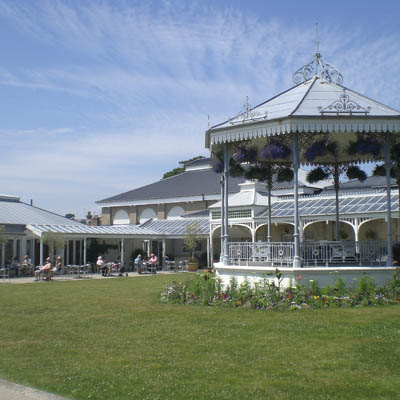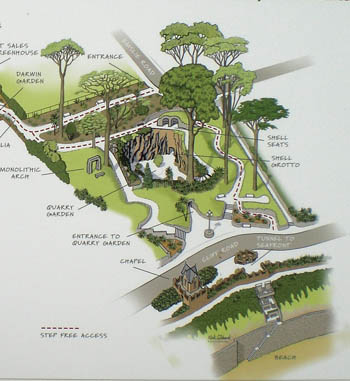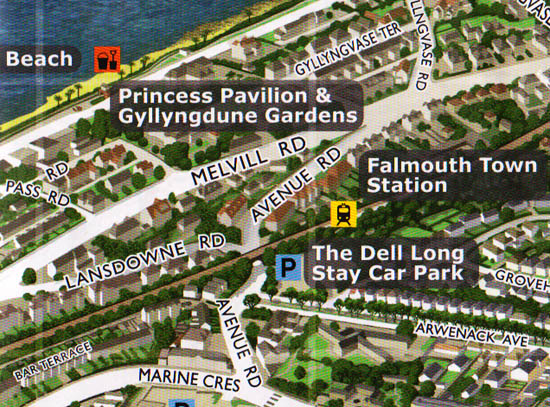
HOME





HOME
|

|

|

|

|
|
P R O F I L E |
||||
|
  Summerlands Grotto
Summerlands GrottoGyllyngdune Gardens and Princess Pavilion 41 Melvill Road Falmouth Cornwall United Kingdom TR11 4AR Telephone: 01326 211222 Fax: 01326 310981 In the early 19th century the estate was much larger. It overlooked the sea on the peninsular of land to the south east of Falmouth town and harbour. The house was originally known as Summerlands and was designed and built by George Wightwick for General William Jessor Coope with stone from the quarry. The quarry's location suggests it was always planned as a quarry garden.
Pictures right
Following the accidental death of the General in 1838 the estate was left to his son, the Rev. W J Coope. He and his family created the gardens, the monolithic arch, rosaries, the grottos and folly. The folly become known as the chapel but was more likely used as a summer house from where the family could walk through the custom built tunnel straight on to their own private beach, now called Tunnel Beach. In 1861, following an action by the parish wardens for obstructing the footpath along the cliffs at the bottom of the garden, the Reverend Coope was ordered to make the path six feet wide throughout the estate's length and allowed to construct two bridges to give access to other parts of his grounds.

Picture: The layout of the quarry garden and access to the beach.In the early 20th century ownership changed hands and this saw parts of the estate sold off for development of housing and roads. Gyllyngdune House became a private hotel. In 1903 Frederick Horniman sold the gardens to the town council before establishing the famous Horniman Museum in London. Only the gardens to the west and south of Gyllyngdune House, were retained as a public amenity. The Princess Pavilion was built with its veranda and cast iron and timber slat seats apparently retrieved from the decks of a Royal Mail steamer and the whole area of Gyllyngdune Gardens was promoted as a winter garden. Princess Alexandra of Teck opened the Princess Pavilion in 1911 which enabled the gardens to accommodate larger, all-weather entertainments. In 1974 Gyllyngdune Gardens were taken over by Carrick District Council.When first conceived, converting the quarry into a garden feature added a highly picturesque component to the landscape providing an ideal space to display exotic planting schemes such as ferns and natural curiosities such as native minerals, corals and shells as well as creating a dark and mysterious atmosphere. A grotto with a seat and lined with shells and pieces of glass was built into the high end of the quarry while above it a small domed seat also lined with shells was built to give views out over the sea. The grotto could be lit with candles that would have given an entrancing effect reflecting off the glass and pieces of mirror. The shell decorations are thought to be the work of Reverend Coope's daughters as it would have been seen to be a suitable occupation for young ladies. The quarry is located below the bandstand towards the sea. There is a tunnel from the quarry giving access to the cliff road and across this there are subterranean steps down to the beach. Above the grotto at the top of the cliff there are now two restored shell seat cavities giving fine views of the quarry gardens and the sea beyond. The grotto comprises a modest underground chamber decorated with shells. It is gated and at the time of visiting in July 2015, was also fenced off, possible because of the danger of cliff falls from above. The whole area is extensively planted with exotic trees and shrubs and can be access along several winding footpaths. Website: Click Here ADDITIONAL INFORMATION 
The Dell is a long stay car park nearby at Falmouth Town railway station, which is convenient for both Gyllyngdune Gardens and Falmouth shopping area and harbour. 
GREAT BRITISH GROTTO GRADING
FACILITIES Access all Year, Access by Road, Access on Foot, Disabled Access, Free Entry, Grotto - just one, Grotto with extensive rock gardens, Part of a larger tourism attraction, Restaurant/Food, Toilets, Tourism Information LANDSCAPE Coastal, Park or Garden, Urban REGION England - Central THE FEATURES PRESENT +Crystals and/or minerals, either natural or simulated, +Dark and mysterious chambers and cave like spaces, +External rock structures, either real or simulated, +Fossils and/or shells incorporated into the decor, +Internal stonework that is natural, recycled or simulated to give a subterranean decor, +Stunning setting and location, +Viewing points from within to an intriguing landscape outside, GRADED SEVEN |
||||
|